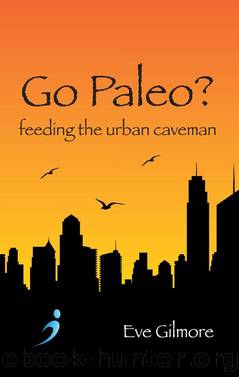Go Paleo? by Eve Gilmore

Author:Eve Gilmore [Eve Gilmore]
Language: eng
Format: epub
ISBN: 9781781610480
Publisher: Hammersmith Books Limited
Published: 2014-01-15T00:00:00+00:00
Chapter 6
Pseudâs corner
In their search for a grain substitute, many turn to alternatives like amarynth and quinoa as they are not technically classified as grains. However, the distinction is more linguistic than scientific. Grains are defined as the seeds of grasses belonging to the Poaceae family.1 âA rose by any other name is still a rose,â as Juliet said to Romeo, and this is why seeds such as chia, buckwheat, quinoa and amarynth are almost identical to cereals both in what they contain and how they behave in the body.
Dr Cordain talks of the âfood foraging theoryâ, which has been used by anthropologists to evaluate energy expenditure versus calorific return when studying hunter-gatherer diets.2 In other words, how much âbang for your buckâ do you get from different foods? Large animals come top of the list, followed by small animals, birds and fish, with cereals coming in last, immediately below nuts and seeds. This means that a nut-, seed- and grain-based diet requires the most preparation and is therefore high in energy and time expenditure but delivers the lowest nutritional return. There is evidence that some hunter-gatherers ate nuts and seeds, but only if their preferred food (meat) was not available, a fact that was confirmed by a study in 2000 of 229 hunter-gatherer diets.3 Furthermore, since seeds are only available for a few months or weeks per year, their contribution to Paleo nutrition would have been minimal. Compare this to the modern diet in which grass seeds have graduated to prime position, making grains our most commonly eaten food.
Plants donât produce seeds as some sort of philanthropic sacrifice to feed other species. As Dr Cordain points out,4 were they to do so they would rapidly become extinct. Plants produce seeds as a means of procreation and have therefore evolved a number of strategies to ensure their survival if eaten by predators. Anti-nutrients are a popular method of protection, as we have already seen. They may alternatively house the seed in a hard shell â otherwise known as a nut, or surround it by a soft fruit such as a peach or plum, or they may grow thorns. Fruits that contain stones tend to be high in polysaccharides, a type of sugar that people with irritable bowel syndrome often find difficult to digest and absorb.
Amarynth, quinoa, buckwheat and some other seeds are known as âpseudo grainsâ, getting off on a technicality since the only difference between them and a cereal is the family to which they belong. Like grains, they have a high loading of anti-nutrients and substandard nutritional content. However, occasional consumption would mimic the way they would have been eaten in Stone Age times. The problem today5 is that foods are available all year round. Seasonal availability and changes in location meant that foods would traditionally have been eaten on a rotational basis. Today the same foods may be eaten daily, and in quantities that could expose us to levels of anti-nutrients sufficient to induce low-level, chronic inflammation and increase our susceptibility to allergies and autoimmune disease.
Download
This site does not store any files on its server. We only index and link to content provided by other sites. Please contact the content providers to delete copyright contents if any and email us, we'll remove relevant links or contents immediately.
Clinical Nutrition For Dummies by Rovito Michael J(514)
The Ultimate Meatless Anabolic Cookbook by Doucette Greg(463)
Cooking with Microgreens by Sal Gilbertie(434)
Natural vitamin E α-tocotrienol: Retention in vital organs in response to long-term oral supplementation and withdrawal by Viren Patel1 Savita Khanna1 Sashwati Roy1 Omar Ezziddin1 & Chandan K. Sen1†(338)
The five-elements wellness plan by Barbara Temelie(321)
Best Green Eats Ever: Delicious Recipes for Nutrient-Rich Leafy Greens, High in Antioxidants and More by Katrine Van Wyk(297)
Jack London by Calcaiul De Fier(282)
Unlock Your Macro Type by Christine Hronec(219)
The Metabolism Miracle, Revised Edition by Diane Kress(210)
Metabolism Makeover by Megan Hansen(202)
Cu-RE Your Fatigue by Robbins Morley(195)
The Personalized Diet_ The Pioneering Program to Lose Weight and Prevent Disease_trial by Eran Segal Phd(191)
The Mayo Clinic Diet-The Healthy Approach to Weight Loss by Unknown(175)
Encyclopedia of Sports & Fitness Nutrition by Liz Applegate Ph.D(151)
Weight Loss Salvation : How Real People Lose Weight and Keep It Off by Stuart McRobert; Bradley Cailor(150)
True Nutrition by March Cocó;(143)
Histamine Intolerance Food List by Carla Mahon & Carla Mahon(141)
The Methylation Miracle by Paul Frankel Ph.D(141)
Why Women Need Fat by William D. Lassek M.D(138)
